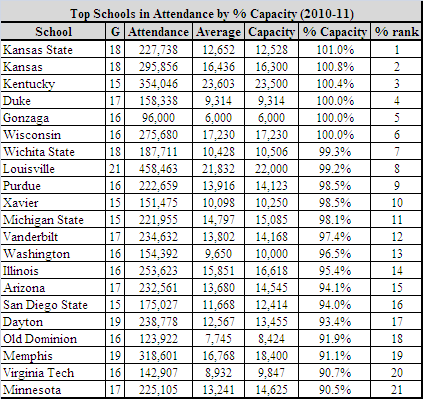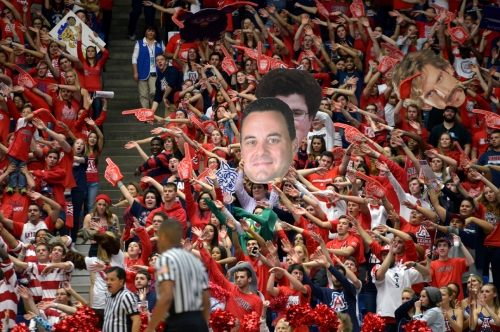Posted by rtmsf on April 27th, 2011
It’s always interesting to see the numbers when the NCAA releases its annual attendance figures for the prior season. After all, ticket sales are still what drives the operating budget of most of these schools, and if a coach can’t consistently put fannies in the seats, he’s unlikely to have a job for very long. The NCAA’s figures, though, mostly deal in the aggregate: A total of 27.6 million fans attending Division I men’s basketball games; the usual suspects, Kentucky, Syracuse, North Carolina and Louisville, leading the way; the Big East cracking the three million mark with its sixteen-team lineup. While it’s interesting to know that those schools and leagues are getting massive numbers of people through the turnstiles, it doesn’t really tell us the whole story without the subcontext of arena size. Duke’s Cameron Indoor Stadium is the classic example — Duke ranks #48 in total home attendance (158,338 fans), but that figure represents 17 home dates at 100% capacity (9,314 fans each game) — so the truth here is that demand for seats within CIS far equals (or more likely, outstrips) availability. Let’s take a look at some of the schools in the NCAA’s top 100 from the perspective of that alternate reality.

Changes things a little, right? Twenty-one of the top 100 schools in average attendance were at 90% or higher in capacity last season. And although some of the bigger arenas such as those at Kentucky (#3), Louisville (#8) and Memphis (#19) are still represented, this metric gives some love to the smaller-capacity schools like K-State (#1), Gonzaga (#5), Wichita State (#7) and others who consistently sold out (or nearly did so) every night the home team took the floor. Some extra props need to go to the high-mids who support their teams through thick and thin, as seven of the top 21 on this list came from non-BCS conferences.
Read the rest of this entry »
| rtc analysis
| Tagged: alabama, arkansas, attendance, bradley, butler, byu, charlotte, cincinnati, georgetown, gonzaga, hawaii, jim larranaga, kentucky, lon kruger, louisville, marshall, memphis, miami (fl), mike anderson, missouri, ncs tate, northwestern, ohio st, oregon st, pittsburgh, south carolina, south florida, syracuse, temple, ucla, unc, unlv, usc, villanova, virginia, wichita st
Share this story















































